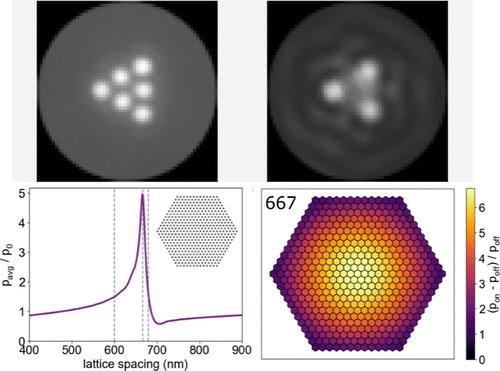当前位置:
X-MOL 学术
›
J. Phys. Chem. C
›
论文详情
Our official English website, www.x-mol.net, welcomes your feedback! (Note: you will need to create a separate account there.)
Electrodynamic Interference and Induced Polarization in Nanoparticle-Based Optical Matter Arrays
The Journal of Physical Chemistry C ( IF 3.7 ) Pub Date : 2024-04-26 , DOI: 10.1021/acs.jpcc.3c08459 Curtis Peterson 1, 2 , John Parker 2, 3 , Emmanuel Valenton 1, 2 , Yuval Yifat 2 , Shiqi Chen 1, 2 , Stuart A. Rice 1, 2 , Norbert F. Scherer 1, 2
The Journal of Physical Chemistry C ( IF 3.7 ) Pub Date : 2024-04-26 , DOI: 10.1021/acs.jpcc.3c08459 Curtis Peterson 1, 2 , John Parker 2, 3 , Emmanuel Valenton 1, 2 , Yuval Yifat 2 , Shiqi Chen 1, 2 , Stuart A. Rice 1, 2 , Norbert F. Scherer 1, 2
Affiliation

|
Optical matter (OM) arrays are self-organizing, ordered arrangements of nanometer- to micrometer-size particles, where interparticle forces are mediated by incident and scattered coherent light. The structures that form and their dynamics depend on the properties (e.g., material, size) of the constituent particles, as well as the incident and scattered light. While significant progress has been made toward understanding how the OM arrays are affected by the phase, polarization, and intensity profile of the incident light, the polarization induced in the particles and the light scattered by OM arrays have received less attention. In this paper, we establish the roles of electrodynamic interference, many-body coupling, and induced-polarization concomitant with the coherent light scattered by OM arrays. Experiments and simulations together demonstrate that the spatial profile and directionality of coherent light scattered by OM arrays in the far field are primarily influenced by interference, while electrodynamic coupling (interactions) and the associated polarization induced in the nanoparticle constituents have a quantitative wavelength-dependent effect on the total amount of light scattered by the arrays. Furthermore, the electrodynamic coupling in silver nanoparticle OM arrays is significantly enhanced by constructive interference and increases superextensively with the number of particles in the array. Particle size, and hence polarizability, also has a significant effect on the strength of the coupling. Finally, we simulate larger hexagonal OM arrays of Ag nanoparticles to demonstrate that the electrodynamic coupling and scattering enhancement observed in small OM arrays develop into surface lattice resonances observed in the infinite array limit. Our work provides insights for designing OM arrays to tune many-body forces and the coherent light that they scatter.
中文翻译:

基于纳米粒子的光学物质阵列中的电动干涉和感应偏振
光学物质(OM)阵列是纳米到微米尺寸粒子的自组织、有序排列,其中粒子间力由入射和散射相干光介导。形成的结构及其动力学取决于组成颗粒的特性(例如材料、尺寸)以及入射光和散射光。虽然在理解 OM 阵列如何受到入射光的相位、偏振和强度分布的影响方面已经取得了重大进展,但颗粒中诱发的偏振和 OM 阵列散射的光受到的关注较少。在本文中,我们建立了电动干涉、多体耦合和感应偏振以及 OM 阵列散射相干光的作用。实验和模拟共同证明,远场中 OM 阵列散射的相干光的空间轮廓和方向性主要受到干涉的影响,而电动耦合(相互作用)和纳米粒子成分中引起的相关偏振具有定量的波长相关效应阵列散射的光总量。此外,银纳米颗粒 OM 阵列中的电动耦合通过相长干涉显着增强,并且随着阵列中颗粒数量的增加而大幅增加。颗粒尺寸以及极化率对耦合强度也有显着影响。最后,我们模拟了较大的六角形 OM 纳米颗粒阵列,以证明在小型 OM 阵列中观察到的电动耦合和散射增强发展为在无限阵列极限中观察到的表面晶格共振。我们的工作为设计 OM 阵列提供了见解,以调整多体力及其散射的相干光。
更新日期:2024-04-27
中文翻译:

基于纳米粒子的光学物质阵列中的电动干涉和感应偏振
光学物质(OM)阵列是纳米到微米尺寸粒子的自组织、有序排列,其中粒子间力由入射和散射相干光介导。形成的结构及其动力学取决于组成颗粒的特性(例如材料、尺寸)以及入射光和散射光。虽然在理解 OM 阵列如何受到入射光的相位、偏振和强度分布的影响方面已经取得了重大进展,但颗粒中诱发的偏振和 OM 阵列散射的光受到的关注较少。在本文中,我们建立了电动干涉、多体耦合和感应偏振以及 OM 阵列散射相干光的作用。实验和模拟共同证明,远场中 OM 阵列散射的相干光的空间轮廓和方向性主要受到干涉的影响,而电动耦合(相互作用)和纳米粒子成分中引起的相关偏振具有定量的波长相关效应阵列散射的光总量。此外,银纳米颗粒 OM 阵列中的电动耦合通过相长干涉显着增强,并且随着阵列中颗粒数量的增加而大幅增加。颗粒尺寸以及极化率对耦合强度也有显着影响。最后,我们模拟了较大的六角形 OM 纳米颗粒阵列,以证明在小型 OM 阵列中观察到的电动耦合和散射增强发展为在无限阵列极限中观察到的表面晶格共振。我们的工作为设计 OM 阵列提供了见解,以调整多体力及其散射的相干光。



























 京公网安备 11010802027423号
京公网安备 11010802027423号